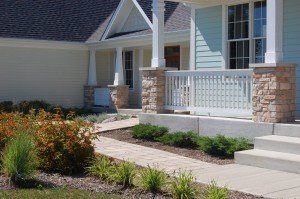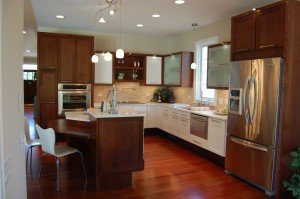New American Homes, the builder of Newport Cove, has been in the home building business since the mid-1980s. Over the course of those years, we have been asked four different times to retrofit a home we had built to accommodate a person who – due to either accident or illness – had become wheelchair bound. Then, in each of those instances, once the home owners had decided to move from their residences, we were again hired to remove all of the accessibility features so that the home could be sold.
It is very difficult to sell a home that LOOKS accessible. Buyers do not want to be reminded of the world’s difficulties, the trials and tribulations of illness and aging.
Because of these experiences, we became interested in accessible housing. It seemed foolish to build a house, retrofit a house and then remove the retrofitting. The solution, of course, is a design that does not scream accessibility. Over the years we have begun adding several accessible features to our homes. We – as a matter of course – build wider hallways, wider doorways and stacked closets. But, the kitchens and baths are always the big challenge. The average buyers still want the private water closet. They shy away from grab bars. They want storage space under their vanity sinks.
This all led to the building of our LIFEhouse, a concept home we are just completing in our Newport Cove waterfront community on the Chain O’ Lakes.
 The LIFEhouse is a 2,000 square-foot-ranch home with a full basement. The floor plan is simply one of our standard models TWEAKED a bit so that it follows the principles of “universal design.” Much of the house is accessible; the rest could easily become so.
The LIFEhouse is a 2,000 square-foot-ranch home with a full basement. The floor plan is simply one of our standard models TWEAKED a bit so that it follows the principles of “universal design.” Much of the house is accessible; the rest could easily become so.The home’s entrances are no-step. The front porch camouflages a brick paver ramp that comes off the front sidewalk. The front door is 42 inches wide. The house has a lift that stops at the garage, the first floor and the lower level. The kitchen, master bath and lower level bath are fully accessible. A third bath is semi-accessible. The home has many, many features that are universally designed. Yet, it is an attractive home. It is trendy, young-feeling – not at all hospital-like.
As you know, elevators and lifts are budget busters, as are some of the new high-tech options – but the little things, including more and better lighting, accessible hardware and faucets, well-placed appliances – these things are easy and inexpensive.
For us, the challenge is to create a universally designed home package that is more or less the same cost as one of our standard homes. That’s the challenge.
So, here’s a question: Would you pay extra for the security of remaining in your home as your lifestyle changes?

